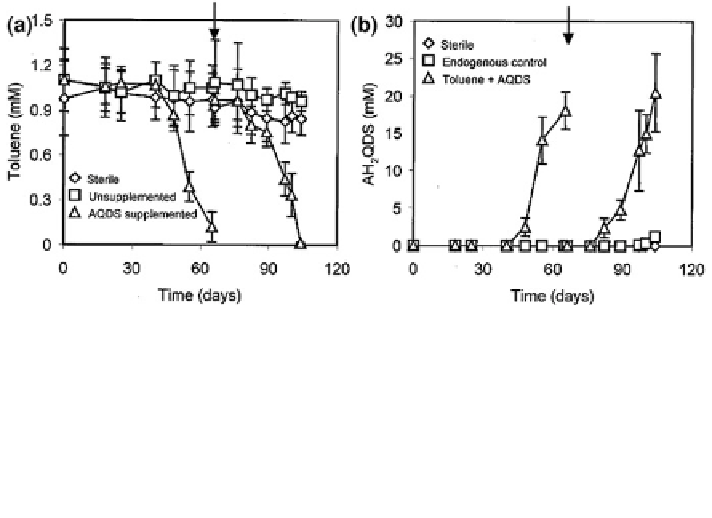Geoscience Reference
In-Depth Information
Fig. 16.33 Simultaneous a toluene conversion and b AQDS reduction by Amsterdam petroleum
harbor sediment in anaerobic culture bottles containing bicarbonate-buffered basal medium,
supplemented with 25 mM AQDS. The unsupplemented control was prepared in the same
manner but without AQDS. The endogenous control (without toluene addition) contained the
same amount of hexadecane (0.2 % [vol/vol]) as that used for toluene addition. AQDS reduction
was quantified spectrophotometrically as the increase in absorbance at 450 nm. Data are means
and standard deviations for triplicate incubations in each treatment. Arrows indicate the addition
of fresh medium containing AQDS and toluene in depleted bioassay mixtures (Cervantes et al.
2001
). Reprinted with permission. Copyright American Society for Microbiology
degradation pathways under anaerobic conditions tend to develop. Cervantes et al.
(
2001
) tested the possibility of microbially mediated mineralization of toluene by
quinones and humus as terminal electron acceptors. Anaerobic microbial oxidation
of toluene to CO
2
, coupled to humus respiration, was demonstrated by the use of
enriched anaerobic sediments (e.g., from the Amsterdam petroleum harbor).
Natural humic acids and humic quinone moiety models (anthraquinone-2,-6-di-
sulfonate, denoted AQDS) were used as terminal electron acceptors. Toluene was
added to the basal medium, supplemented by HA or AQDS, and incubated for
120 days. The biologically active sediments containing bicarbonate-buffered
degradation were tested by including in the experiment a variable with sterile
(autoclaved) sediment. To study the mineralization of toluene to CO
2
, under
anoxic quinone and humus-respiring conditions, enrichment cultures from sedi-
ment samples were incubated with uniformly
13
C-labeled toluene. From
Fig.
16.33
A, we see that the sediment degraded toluene when a quinone moiety
(AQDS) was included in the medium. In the sediment, toluene was completely
eliminated after two months of incubation. Figure
16.33
B shows a concomitant
reduction of AQDS to AH
2
QDS. The same treatment on autoclaved sediment,
however, did not lead to toluene reduction.
To validate mineralization of toluene to CO
2
under anoxic quinone and humus-
respiring conditions, Cervantes et al. (
2001
) performed additional experiments
using enriched phosphate-buffered basal sediments from Amsterdam petroleum
harbor. After two weeks of incubation, 85 % of added
13
C-labeled toluene was
13
CO
2
. Enriched sediment converted
13
C-labeled toluene to
13
CO
2
in
observed as

